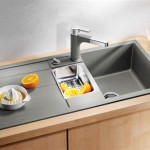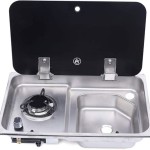How To Plumb A Kitchen Sink
Installing a kitchen sink can be a daunting task, but with the right tools and materials, it can be surprisingly manageable. Follow these steps to successfully plumb a kitchen sink like a pro.
Tools and Materials:
* Adjustable wrench * Plumber's putty * Hacksaw * Sink strainer * Garbage disposal (optional) * P-trap * Supply lines * FaucetStep 1: Preparing the Sink Hole
Place the sink in the countertop cutout and mark the outline with a pencil. Using a hacksaw, carefully cut out the hole, ensuring it is slightly smaller than the marked outline to allow for expansion and movement.
Step 2: Installing the Strainer and P-Trap
Apply a generous bead of plumber's putty around the rim of the sink strainer and insert it into the drain hole. Tighten the locking nut underneath the sink to secure it.
Assemble the P-trap by connecting the curved pipe to the drainpipe and the vertical tailpiece to the strainer. Hand-tighten all connections.
Step 3: Installing the Garbage Disposal (Optional)
If installing a garbage disposal, connect it to the P-trap tailpiece. Secure the disposal with the supplied mounting brackets and connect the electrical wiring according to the manufacturer's instructions.
Step 4: Connecting the Supply Lines
Connect the cold and hot water supply lines to the corresponding valves on the faucet. Use an adjustable wrench to hand-tighten the lines securely.
Step 5: Setting the Sink in Place
Apply a bead of plumber's putty around the rim of the sink and carefully place it into the countertop hole. Press down gently and wipe away any excess putty.
Step 6: Tightening the Faucet and Drain
Insert the faucet into the pre-drilled holes on the sink and secure it with the mounting hardware and washers. Tighten the drain assembly and all other connections.
Step 7: Testing the System
Turn on the water supply and check for any leaks at the connections. If there are no leaks, the installation is complete.
Additional Tips:
* Use high-quality materials to ensure durability and longevity. * Check local codes and regulations to determine any specific requirements. * If unsure about any step, do not hesitate to consult a professional plumber. * Before tightening any connections, ensure correct alignment and fit. * Regularly inspect and maintain the plumbing system to prevent future issues.
How To Connect A Kitchen Sink Drain

How To Install A Kitchen Sink Step By Guide

How To Connect A Kitchen Sink Drain 2024

Kitchen Sink Plumbing How To Make A Drain Better

How To Install Kitchen Sink Drain For Beginners

How To Install Dual Kitchen Sink Drain Plumbing Pipes
How To Install A Kitchen Sink Drain

Kitchen Sink Drain Through Floor P Trap Arm Length

How To Install A Kitchen Sink Drain

Kitchen Plumbing Systems Hometips







